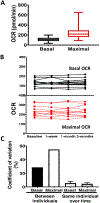Blood-based bioenergetics: An emerging translational and clinical tool
- PMID: 31864667
- PMCID: PMC7031032
- DOI: 10.1016/j.mam.2019.100835
Blood-based bioenergetics: An emerging translational and clinical tool
Abstract
Accumulating studies demonstrate that mitochondrial genetics and function are central to determining the susceptibility to, and prognosis of numerous diseases across all organ systems. Despite this recognition, mitochondrial function remains poorly characterized in humans primarily due to the invasiveness of obtaining viable tissue for mitochondrial studies. Recent studies have begun to test the hypothesis that circulating blood cells, which can be obtained by minimally invasive methodology, can be utilized as a biomarker of systemic bioenergetic function in human populations. Here we present the available methodologies for assessing blood cell bioenergetics and review studies that have applied these techniques to healthy and disease populations. We focus on the validation of this methodology in healthy subjects, as well as studies testing whether blood cell bioenergetics are altered in disease, correlate with clinical parameters, and compare with other methodology for assessing human mitochondrial function. Finally, we present the challenges and goals for the development of this emerging approach into a tool for translational research and personalized medicine.
Keywords: Bioenergetics; Biomarker; Blood cell; Mitochondria; Platelets; Precision medicine.
Copyright © 2019 Elsevier Ltd. All rights reserved.
Conflict of interest statement
Declaration of competing interest None.
Figures




References
-
- Granatiero V, De Stefani D, Rizzuto R. Mitochondrial Calcium Handling in Physiology and Disease. Adv Exp Med Biol. 2017;982:25–47. - PubMed
Publication types
MeSH terms
Substances
Grants and funding
LinkOut - more resources
Full Text Sources
Other Literature Sources

